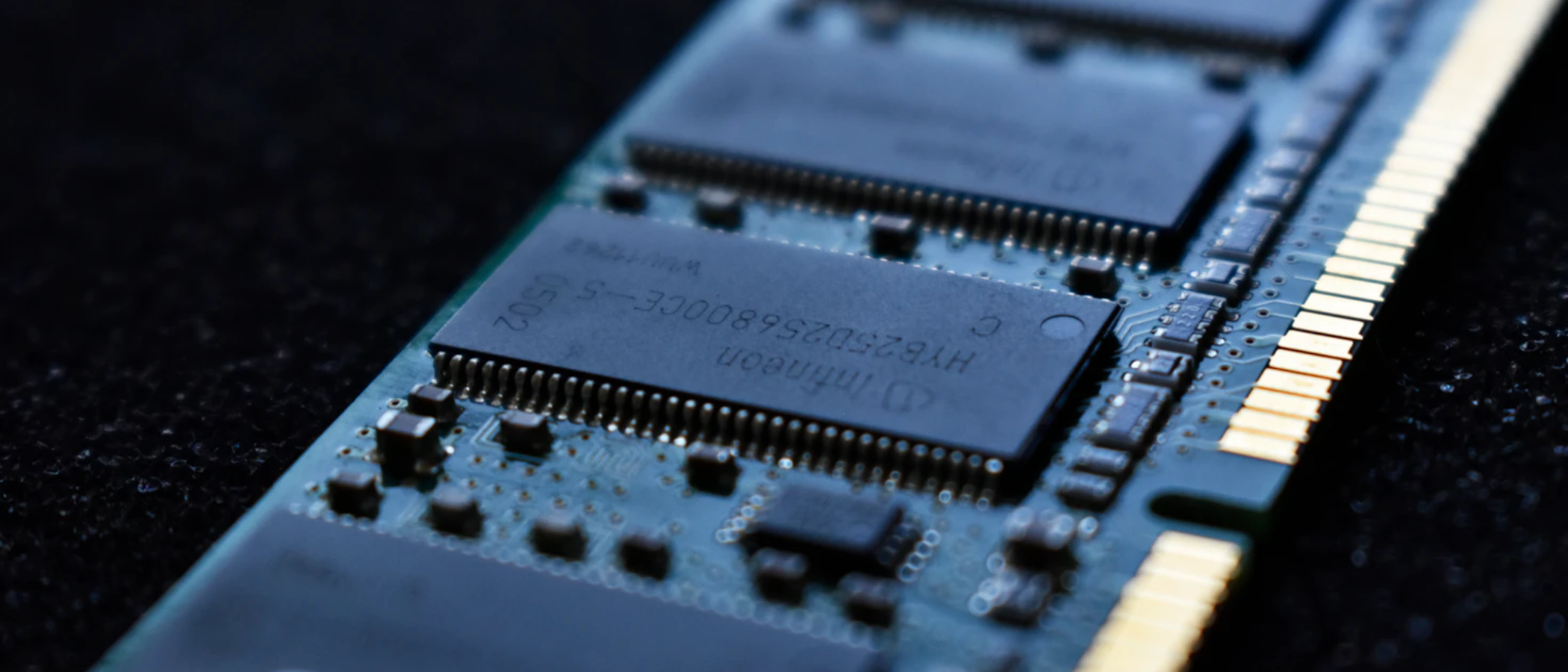Random Access Memory: what it is, how RAM is used, what benefits does it deliver to the business?
We look at what RAM is, the different types out there, and why it's so important in the running of your business

We have covered what is RAM briefly previously. At its simplest, RAM (Random Access Memory) is a type of computer memory, often referred to as short-term memory because it is volatile, meaning that the data is not saved when the power is turned off. Stay tuned if you want to get a bit more technical.
When business users switch on the computer, the operating system and applications are loaded to the computer RAM which is directly connected to the CPU, making the data quickly accessible for processing.
In corporate settings, RAM (memory modules) comes in different shapes and sizes. DIMM (Dual In-Line Memory Module) can be found in desktops, workstation PCs. and servers, while laptops require smaller physical size SODIMM (Small Outline DIMM).
A memory module contains several DRAM (Dynamic RAM) chips which is a type of semiconductor memory. Dynamic simply means that the data held by transistors in the chips is constantly refreshed. The number of DRAM chips found on a memory module varies depending on its capacity (8GB, 16GB, 32GB).
The lithography of DRAM chips has been revised and improved many times over recent decades and this has led not only to reductions in cost-per-bit, but also to reducing the dimensions of the component and increasing the clock rate. Overall, DRAM now delivers faster performance and higher capacities but uses less power which cuts energy costs, controls heat and extends battery life.
DRAM operate in one of two modes, synchronous or asynchronous. Asynchronous was the common DRAM technology used up until the end of the 1990s. Synchronous mode means that read, write and refresh operations are controlled with a system clock, synchronous with the clock speed of a computer’s CPU. Today’s computers use synchronous mode, or Synchronous Random Access Memory (SDRAM) which connects to the system board via a memory module.
DDR5: the new kid in the memory lane
The latest version of SDRAM is DDR5 (Double Data Rate 5th generation), which comes in a range of standard speeds, starting with 4800M/Ts (megatransfers per second) and is an indicator of the speed at which data is transferred on and off the memory module. Approximately every seven years, a new memory generation is introduced, which is designed to accommodate the ever-increasing demand for speed, density and configurations in business computing environments. DDR5 RAM, for example, is designed with new features that provide higher performance, lower power and more robust data integrity for the next decade of computing. It debuted in 2021.
Are you a pro? Subscribe to our newsletter
Sign up to the TechRadar Pro newsletter to get all the top news, opinion, features and guidance your business needs to succeed!
IT decision makers who are considering purchasing memory must be aware that memory modules are not backwards compatible. DDR5 memory will not physically slot into a DDR4 or DDR3 memory socket. Within a memory generation, faster speeds are backwards compatible. For example, if a user buys a standard DDR5–5600MT/s module and uses it with a 12th Generation Intel processor, the speed memory will automatically ‘clock down’ to operate at 4800M/Ts, the speed supported by the host system or lower. This will vary depending on the model of the CPU and the number of memory modules installed in the system.
It’s essential to know the processor and motherboard already installed in the computer when planning on upgrading memory, but there are some other considerations too. Most PCs have four RAM sockets, some, such as workstations, have as many as eight, but laptops are likely to have only two accessible memory sockets, and in thin models, there may only be one.
Different types of RAM
Even though they may look similar and have the same function, the type of memory module found in HEDT (High-End Desktop) and servers is different than the ones found in PCs. Intel Xeon and the AMD Epyc range of server CPUs come with a higher number of CPU cores and more memory channels compared to Intel Core and AMD Ryzen desktop CPUs, therefore the specifications and features of the RAM for servers differ from the ones for PCs. Server CPUs require Registered DIMM which supports the ECC (Error Correcting Code) feature, allowing to correct bits error occurring on the memory bus (between the memory controller and the DRAM chip), ensuring the integrity of the data. RDC (Registered Clock Driver) is an additional component found on RDIMM, not present on Unbuffered DIMM (UDIMM), and it ensures that all components on the memory module are operating at the same clock cycle allowing the system to remain stable when a high number of modules are installed.
The type of memory module made for desktops and laptops is generally Non-ECC Unbuffered DIMM. The data processed by users on these types of systems is considered less critical than the data being processed by servers which are hosting websites or handling online transactional processing, for example, and need to respect specific SLAs (Service-Level Agreements) and up times of 99.9999% 24/7. Non-ECC UDIMMs contain less components and features than RDIMMs and are therefore more affordable while remaining a reliable memory solution. Unbuffered types of RAM exist in both DIMM and SODIMM form factor.
Boosting performance
RAM memory is primarily sold in single modules, but it is also available in kits of two, four or eight, ranging in capacity from 4GB for DDR3 to 96GB for DDR5 (in single modules) and up to 256GB in kits (256GB is offered only as a kit of 8 in DDR4 and DDR 5). The configurations match the memory channel architecture, and when installed correctly can deliver a major boost in performance. To provide an example of the performance potential, upgrading a DDR5-4800MT/s module with a peak bandwidth of 38.4 GB/s to a dual channel setup, instantly expands the bandwidth to 76.8GB/s.
Accelerating speed
Users with industry standard speeds are limited to what their computer’s processor and motherboard will support, particularly if it won’t allow modules to be installed into a second memory bank. On a dual channel motherboard with four sockets, these are arranged in two memory banks, where each memory channel has two sockets. If a DDR5 user can install modules into a second bank, in most cases, the memory may be forced to clock-down to a slower speed to allow for limitations inside the processor.
Users looking for a considerable boost, such as gamers, can opt for overclockable memory. This can be done safely using Intel XMP and AMD EXPO profiles however, professional help is advisable. Selecting the right gaming memory for overclocking a system means deciding on price verses speed versus capacity, the potential limitations of motherboards and processors, and RGB versus non-RGB (to bring in the benefits of lighting).
Useful glossary of terms
Apart from the acronyms we’ve already explained above, here are some additional terms that it will be useful to know:
CPU – Central Processing Units are the core of the computer.
PMIC – Power Management Integrate Circuits help to regulate the power required by the components of the memory module. For server-class modules, the PMIC uses 12V; for PC-class modules, it uses 5V.
SPD hub – DDR5 uses a new device that integrates the Serial Presence Detect EEPROM with additional features, manages access to the external controller and decouples the memory load on the internal bus from external.
On-die ECC Error Correction Code that mitigates the risk of data leakage by correcting errors within the chip, increasing reliability and reducing defect rates.
2CH, 4CH, 8CH – Single RAM modules – dual channel, quad channel, octal channel.
MHz – MHz is an abbreviation of megahertz and means a million cycles per second, or one million hertz. This unit of frequency measurement is used to denote the speed at which data moves within and between components.
MT/s is short for megatransfers (or million transfers) per second and is a more accurate measurement for the effective data rate (speed) of DDR SDRAM memory in computing.
Non-binary memory – The density of DRAM chips usually doubles with each iteration, but with DDR5, an intermediary density – 24Gbit – was introduced, which provides more flexibility and is called non-binary memory.
GB/s - Gigabytes per second. A Gigabyte is a unit of data storage capacity that is approximately 1 billion bytes. It has been a common unit of capacity measurement for data storage products since the mid-1980s.
Read more
- Best business computers: Tested, reviewed, rated
- How to check how much RAM you have
- We try out the best business laptops
Regional Director for UK & Ireland and DRAM Business Manager for the EMEA Region at Kingston Technology.
